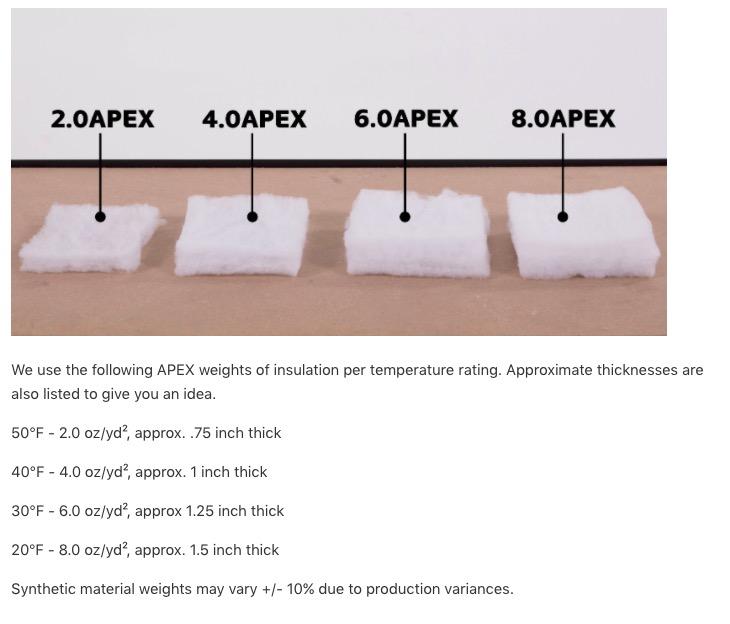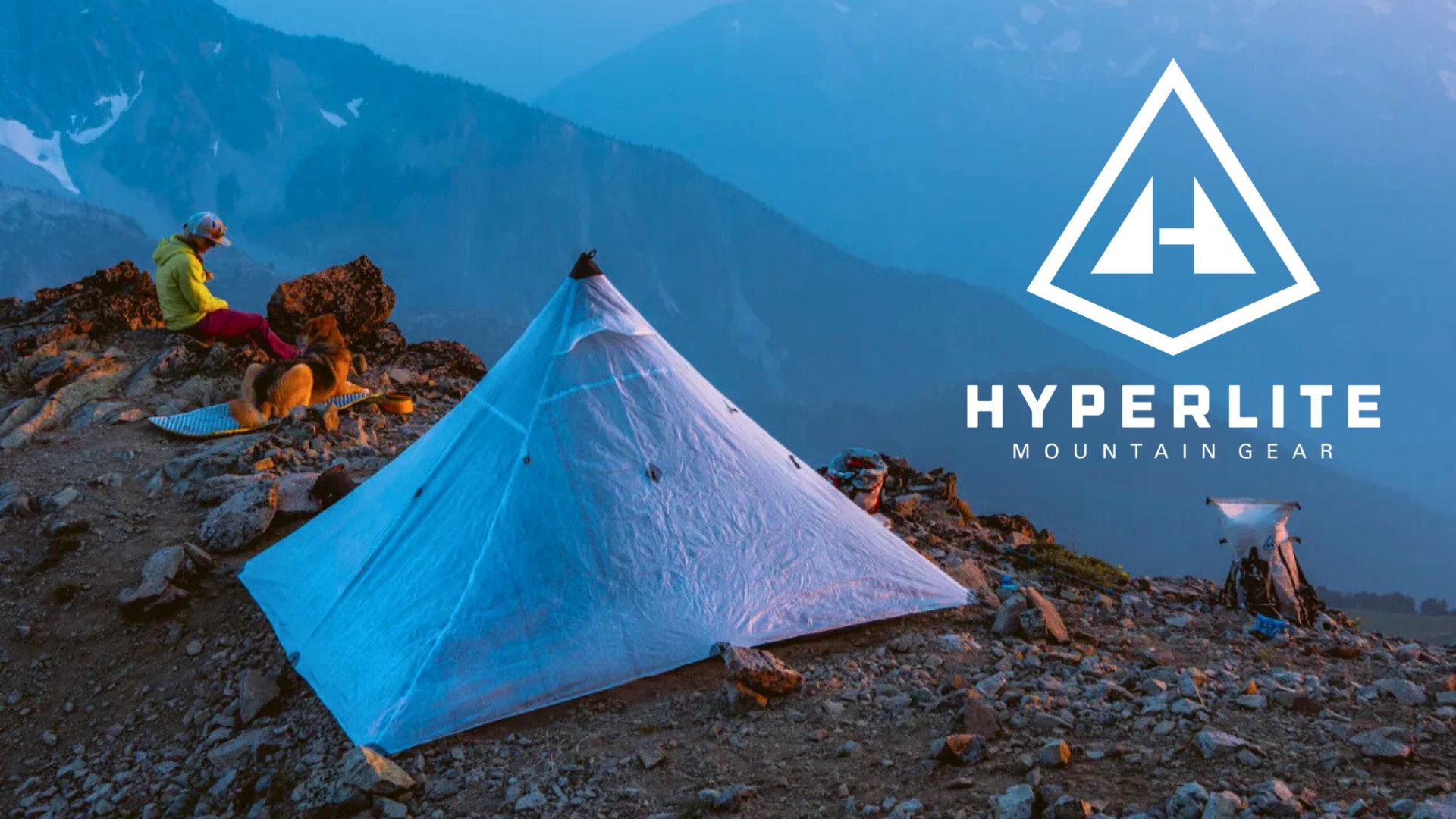Topic
Where to Source Climashield APEX 2.0 / Alternatives for Quilts?
Forum Posting
A Membership is required to post in the forums. Login or become a member to post in the member forums!
Home › Forums › Gear Forums › Make Your Own Gear › Where to Source Climashield APEX 2.0 / Alternatives for Quilts?
- This topic has 10 replies, 5 voices, and was last updated 4 years, 9 months ago by
 Edward John M.
Edward John M.
-
AuthorPosts
-
May 8, 2020 at 5:29 pm #3645885
Hello fellow BPL MYOGers,
Does anybody know where to source Climashield Apex 2.0 oz/sq yd? I see that EE uses this on their quilts (see screenshot), but all the standard MYOG suppliers only supply down to 2.5 oz/sq yd. Am I missing something here?
I would like to use this material in an over-quilt for the winter, but because I don’t plan on going into really frigid temps I would like to use the thinnest/lightest synthetic insulation I can find. I plan to use this over-quilt in combination with a 30 degree F quilt to get down to temperatures around 10-15 degrees F. I should note that one of the main motivations for me to use an over-quilt is to reduce the condensation on my down quilt. I am also all ears if someone has an alternatively effective synthetic insulation (Dutch’s “Up Insulation”, Primaloft, Thinsulate, etc…) that they think would work well for this application.
As always, thank you in advance for your help~
-Kyle May 8, 2020 at 9:13 pm #3645903
May 8, 2020 at 9:13 pm #3645903You can get Apex in any weight you desire from the manufacturer when you are as big as EE, except they cannot makes it lighter than 2.0. MOQ is probably 1K yards.
The rest of us are limited to whatever the reseller of choice (Dutch, Ripstop) decides to carry.
May 9, 2020 at 1:00 am #3645921May 9, 2020 at 8:39 am #3645943Awesome – thanks Mole J!
May 9, 2020 at 8:40 am #3645944Thanks for the info @Nunatak. If I can’t get it from extremtextil, I guess I just need to find a couple hundred buddies that want to build the same quilt as me…
May 10, 2020 at 1:58 am #3646097No problem Kyle.
I just remembered these guys too:
https://www.adventurexpert.com/product/climashield-apex-67/
May 10, 2020 at 9:29 am #3646119Thanks again @ Mole J. I wonder why this weight insulation is not stocked by stores in the US, but is in the EU…
May 10, 2020 at 10:42 am #3646132It’s strange isn’t it?
That in Europe where we use grams, the insulation is sold in thicknesses of units of ounces (33g/m² = 1oz/yd²), and in the US in decimal fractions of ounces…
May 10, 2020 at 4:06 pm #3646169I wonder whether there may be an effective minimum amount of insulation to achieve your desired end. Not the added warmth part, but the moisture management. The main purpose of an overquilt, as I understand it, is to move the dewpoint for internally generated moisture out of your down insulation layer and into the synthetic, where the moisture will be easier to dry out and will have less effect on warmth. Yes, you might have frost forming on the exterior as well, but that tends to be less of an issue in my experience. So at some point, if your synthetic layer gets thin enough, you could end up with the dewpoint still in your down layer. I don’t really know how to calculate any of this. But here’s my logic:
I can tell you that a 2.5 oz apex overquilt, used over a 30 degree rated bag that keeps me warm to about 35 or so on its own, has worked well for me in the low 20’s and upper teens. Thus, about 15 degree difference. Assuming that the dewpoint is effectively at freezing once you get below freezing (since moisture will freeze before it gets out of your sleeping system if it reaches freezing while inside it – and yes, I expect this isn’t exactly right but it’s close), then it seems to me you want the quilt to make up at least the difference between 32 and whatever temperatures you expect to be in. So if you want things to be nice at 10 degrees, I figure you want your overquilt to be adding 22 degrees of warmth. I hardly ever get below the upper teens where I go, so 15 degrees added is about right for me and that has worked out well.
May 10, 2020 at 9:43 pm #3646242Interesting – I am picking up what you are putting down, @Paul. I agree there is likely a point where too thin does nothing (i.e. if you just had a single sheet of nylon). I bet it is kind of a gradient where the thinner the top quilt gets, the less moisture protection it provides (given identical conditions). I’ll probably just end up using 2.5oz because it is more available, and will likely make a better summer-ish stand-alone quilt.
May 12, 2020 at 7:20 pm #3646728I have an excellent UL Nunatak custom overquilt, I dithered for a while before deciding on 100GSM / 3.6 oz as my insulation weight. There isn’t that much difference between final weights really at this insulation level, just a couple of ounces and the safety margin given by using the higher weight insulation is more than marginal. In my case more than made up for by choosing the UL Robic as the shell fabric for the much greater wind resistance.
Just something to think about -
AuthorPosts
- You must be logged in to reply to this topic.
Forum Posting
A Membership is required to post in the forums. Login or become a member to post in the member forums!
LAST CALL (Sale Ends Feb 24) - Hyperlite Mountain Gear's Biggest Sale of the Year.
All DCF shelters, packs, premium quilts, and accessories are on sale.
Our Community Posts are Moderated
Backpacking Light community posts are moderated and here to foster helpful and positive discussions about lightweight backpacking. Please be mindful of our values and boundaries and review our Community Guidelines prior to posting.
Get the Newsletter
Gear Research & Discovery Tools
- Browse our curated Gear Shop
- See the latest Gear Deals and Sales
- Our Recommendations
- Search for Gear on Sale with the Gear Finder
- Used Gear Swap
- Member Gear Reviews and BPL Gear Review Articles
- Browse by Gear Type or Brand.




